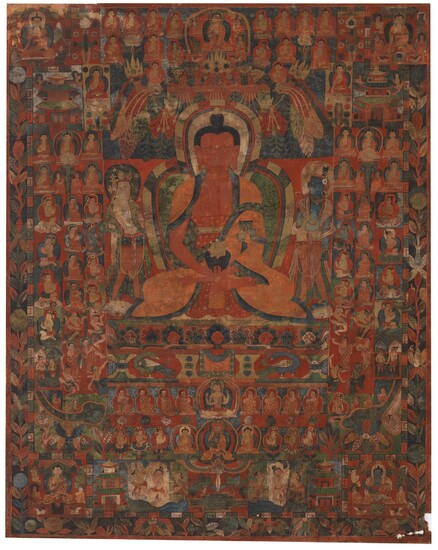A THANGKA DEPICTING AMITABHA IN SUKHAVATI Tibet, Circa 1500
A THANGKA DEPICTING AMITABHA IN SUKHAVATI Tibet, Circa 1500
with hands in dhyana mudra holding a black patra, seated on a peacock throne with the bodhisattva Avalokiteshvara standing to the left and blue Mahasthamaprapta to the right, an elaborate foliate canopy above, a temple in each corner, with Buddhas, monks and adepts throughout, Sadaksari Avalokitesvara below the throne with Padmasambhava flanked by Buddhas and seated on a lotus emerging from a lotus pond beneath, a temple to either side, rivers running throughout, and all bound by a foliate and floral border beneath and to either side
Himalayan Art Resources item no. 18343.
36 1/4 by 28 1/4 in. (92 by 72 cm)
Provenance:
The painting depicts Sukhavati, the Blissful Western Pure Land of Amitabha, the Buddha of Infinite Light. Compare the composition of a Sukhavati painting in the Collection of Shelley and Donald Rubin, see Marylin M. Rhie, Robert A. F. Thurman, Wisdom and Compassion: The Sacred Art of Tibet, Expanded Edition, New York, 1996, p. 470, cat. no. 225. Similarities include the distribution of temple complexes that the authors speculate are the abodes of the Dharma Kings of Tibet. The lotus supporting Padmasambhava, with Sadaksari Avalokitesvara above, is featured in both paintings, as is the floral and foliate border representing the cosmic tree that supports the Pure Land. Rhie and Thurman date the Rubin example to the fourteenth or fifteenth century and identify it as one of the earliest examples of the Sukhavati theme in Tibetan thangka painting, ibid. The present example, dating from circa 1500, is amongst the finest of these early depictions of the Sukhavati Pure Land.
View it on
Estimate
Time, Location
Auction House
A THANGKA DEPICTING AMITABHA IN SUKHAVATI Tibet, Circa 1500
with hands in dhyana mudra holding a black patra, seated on a peacock throne with the bodhisattva Avalokiteshvara standing to the left and blue Mahasthamaprapta to the right, an elaborate foliate canopy above, a temple in each corner, with Buddhas, monks and adepts throughout, Sadaksari Avalokitesvara below the throne with Padmasambhava flanked by Buddhas and seated on a lotus emerging from a lotus pond beneath, a temple to either side, rivers running throughout, and all bound by a foliate and floral border beneath and to either side
Himalayan Art Resources item no. 18343.
36 1/4 by 28 1/4 in. (92 by 72 cm)
Provenance:
The painting depicts Sukhavati, the Blissful Western Pure Land of Amitabha, the Buddha of Infinite Light. Compare the composition of a Sukhavati painting in the Collection of Shelley and Donald Rubin, see Marylin M. Rhie, Robert A. F. Thurman, Wisdom and Compassion: The Sacred Art of Tibet, Expanded Edition, New York, 1996, p. 470, cat. no. 225. Similarities include the distribution of temple complexes that the authors speculate are the abodes of the Dharma Kings of Tibet. The lotus supporting Padmasambhava, with Sadaksari Avalokitesvara above, is featured in both paintings, as is the floral and foliate border representing the cosmic tree that supports the Pure Land. Rhie and Thurman date the Rubin example to the fourteenth or fifteenth century and identify it as one of the earliest examples of the Sukhavati theme in Tibetan thangka painting, ibid. The present example, dating from circa 1500, is amongst the finest of these early depictions of the Sukhavati Pure Land.



